#01: Structural and Thermal Model of the Mercury Planetary Orbiter arrives at ESTEC
5 August 2011
This is the first entry in the BepiColombo Test Campaign Journal, a series of articles covering the main events during the integration and testing of the Structural and Thermal Models (STM) and the Proto-Flight Models (PFM) of the four major components that make up the BepiColombo composite spacecraft stack. The journal is expected to run until the completion of PFM testing in the fourth quarter of 2013; shortly after this, the BepiColombo Launch Campaign Journal will begin.The BepiColombo Mercury Planetary Orbiter (MPO) STM arrived at ESA's European Space Research and Technology Centre (ESTEC) in Noordwijk, the Netherlands, during the night of 29/30 July. It had travelled by road from the Turin facility of Thales Alenia Space, where most of the spacecraft integration was performed under the direction of the Prime Contractor, Astrium GmbH. The journey lasted nearly six days, because the unusually wide load could only travel at night and had to follow a prescribed route. The orbiter travelled in a specially built transport container that maintained it in a temperature and humidity controlled nitrogen atmosphere and provided protection against vibration and shocks.
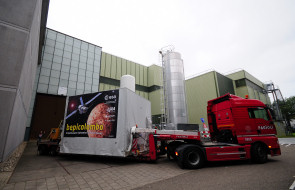 |
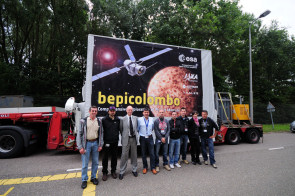 |
|
Left: The MPO arriving at ESTEC. Right: Team members with the MPO transport container. Credit: ESA |
|
Unpacking and Preparation for Testing
On Saturday 30 July, the exterior of the transport container was cleaned in an airlock at the ESTEC Test Centre and moved into a cleanroom. Once it had reached thermal equilibrium overnight, the container was opened; all personnel then left the cleanroom while the nitrogen from the container dispersed. The MPO was then lifted out of the transport container and mounted via its +Z face (the 'bottom' when it is mounted on the launcher) on a ground handling trolley. The trolley allows the spacecraft to be positioned with its Z-axis (the vertical axis in launch configuration) anywhere from vertical to horizontal and to be rotated 360° about its Z-axis, allowing full access.
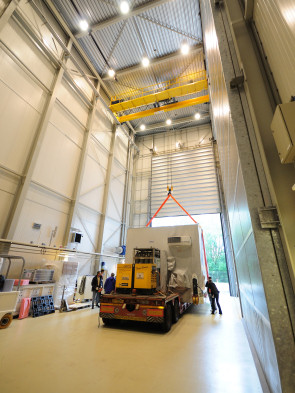 |
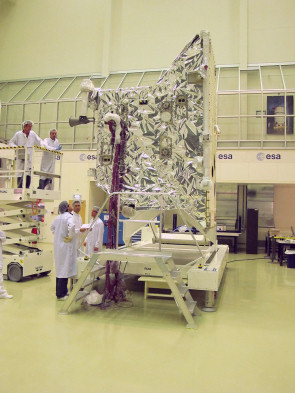 |
|
Above: The MPO transport container enters the airlock at ESTEC. Below: The MPO in the cleanroom at ESTEC. Credit: ESA |
|
A number of additional integration tasks are now being performed, including the installation of the outer, high-temperature thermal protection blankets. These tasks and preparations for the MPO thermal-vacuum test will continue for almost three weeks; the MPO will then be installed in the Large Space Simulator (LSS), beginning on 30 August. Closing of the LSS main chamber after MPO installation and connection of all the test harnesses is currently scheduled for 9 September, followed by pumping and outgassing to achieve the required vacuum of around 10-9 bar. Thermal-vacuum testing is expected to last until the first week of October, with the MPO scheduled to leave the LSS chamber by mid-October.
Harsh Thermal Environment
The BepiColombo MPO will face a particularly challenging thermal environment while in orbit around Mercury. Not only will it be strongly illuminated by the Sun, it will also orbit closer to its host planet than previous spacecraft and will therefore experience much higher levels of infrared radiation on its nadir-pointing panel.
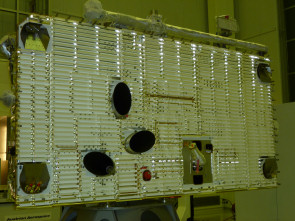 |
|
The MPO radiator. Credit: ESA |
To cope with these demands, the MPO is fitted with two sets of multi-layer thermal insulation blankets; a special 30-layer high-temperature blanket covers a more conventional 10-layer blanket. The outer blanket employs a special fastening technique to avoid the use of mounting holes in the blanket and the protrusion of stand-offs that might be illuminated by the Sun. To minimise conductive coupling between the two blankets, they are kept 15 mm apart and their facing surfaces are highly reflective, to minimise radiative coupling. In total, the MPO is fitted with 66 kg of thermal blankets.
The MPO is equipped with a very large radiator to transfer the heat generated by its internal systems to deep space. Heat from the electronics units inside the spacecraft is carried to the radiator by 93 heat pipes, the majority of which are embedded in the internal structural panels. The radiator takes up one entire panel of the spacecraft. It is protected from infrared radiation coming from Mercury by polished titanium louvres that reflect the incident radiation into space. The louvres will reach a temperature of around 400
A Testing Challenge
Testing to ensure that the MPO design will withstand the thermal environment in Mercury orbit poses a challenge for the LSS. Reflectors in the Sun simulator that focus the radiation from the 19 lamps onto the spacecraft have been adjusted to concentrate the radiation and achieve the highest ever level of illumination – 10 solar constants. To be able to maintain a sufficiently low temperature on the thermal shrouds that surround the MPO to simulate the cold of deep space, the flow rate of the liquid nitrogen that cools the shrouds has been increased by a factor of six, to 5000 l/hr. An additional shroud has been installed to cool the MPO radiator.
Both Hot and Cold
It might seem odd that a spacecraft in orbit around Mercury and so close to the Sun has to be able to withstand extreme cold, as well as extreme heat. In the vacuum of space, the only heat transfer mechanism for the spacecraft is radiation; the convection cooling of hot surfaces experienced at Earth's surface is absent. The result is that those parts of the orbiter that are illuminated by the Sun or Mercury become extremely hot, since there is no way for them to dissipate the incoming energy other than re-radiation. Those areas of the orbiter that are in shadow or pointed away from infrared sources radiate thermal energy into deep space, which has a temperature of about -270
During the two weeks of thermal-vacuum testing, temperatures in and on the MPO will be monitored by around 550 thermocouples, connected to a dedicated thermal data handling system.
About BepiColombo
BepiColombo is Europe's first mission to Mercury. It is scheduled to launch in August 2015 and arrive at Mercury in January 2022. It will endure temperatures in excess of 350
BepiColombo is a joint mission by ESA and the Japan Aerospace Exploration Agency (JAXA), executed under ESA leadership. The Prime Contractor for BepiColombo is Astrium GmbH.





